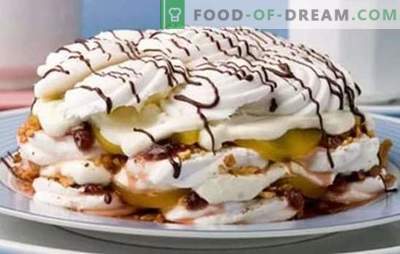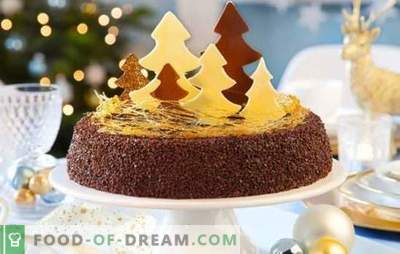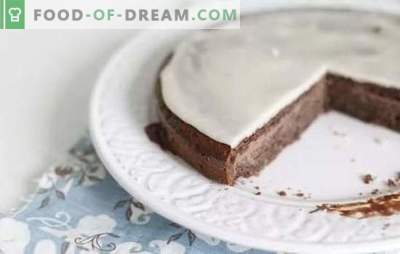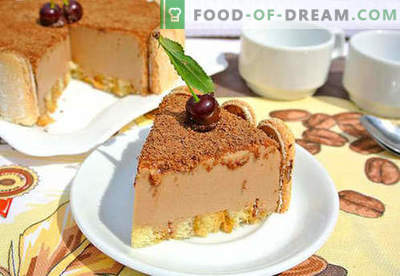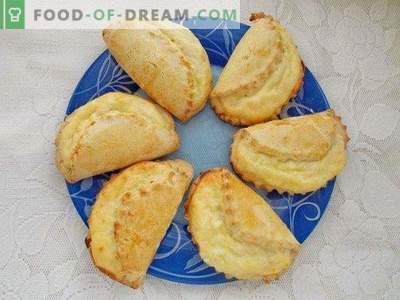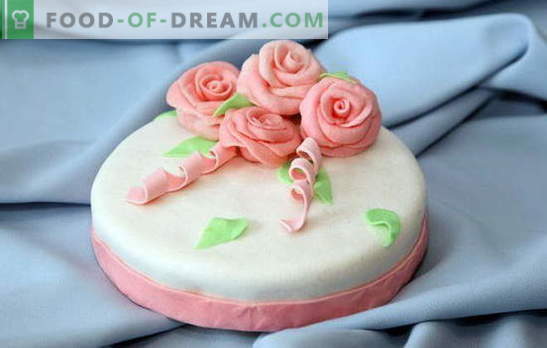
Homemade cake is the most delicious dessert and many housewives can cook it.
All stages of its preparation, subject to the formulation and use of fresh and high-quality products, are not particularly difficult.
In addition, modern household appliances significantly ease the work and reduce the time spent in the kitchen, which is a great advantage compared to the recent times when to get a fluffy cream or biscuit it was necessary to rotate the whisk until exhaustion.
The cost price of homemade desserts is an additional argument in favor of making them with your own hands.
But the question of decorating a homemade cake causes a feeling of insecurity in many, at least. There are various ways to solve this problem: the cake is simply not decorated, or they use ready-made confectionery - chocolate medallions, marmalade pieces, nuts, or raisins in chocolate or in the glaze. Of course, this is the way out. But such a solution does not satisfy those for whom confectionery art is a favorite hobby, in which there is a desire to constantly improve their skills.
Decorations of sugar mastic for cakes at home were invented in the middle of the last century, when there were no electric mixers and “smart” ovens with timers and thermometers, but the need to create beauty in everything already existed. Therefore, the methods of creating jewelry were invented simple and quite feasible. One of these methods is sugar mastic for cake. At home, this decoration option does not pose any difficulty. To overcome the far-fetched fear - “I can’t exactly do it” - it’s enough to remember how in childhood we each molded plasticine figurines. Then, after all, there was no fear? So everything will work out.
You can buy in specialized stores ready-made sugar mastic for the cake. At home, cooking it is also not difficult.
Sugar mastic for cake at home - the basic technological principles
To begin, let us examine the question of what constitutes mastic, and what result is necessary to get in order to easily create decorations of any complexity from sugar mastic for a cake at home.
As already mentioned, the consistency of it should be similar to clay: flexible, with a connected structure, without lumps. To harden sugar mastic for cake at home should not immediately. This condition is feasible when using the appropriate components for binding.
These properties are inherent in even ordinary wheat flour dough: after all, the dough also dries, retaining a certain shape, if left in the air. If wheat flour to brew, then it turns into a sticky mass. But this ingredient is not quite suitable for the taste of sugar paste. Therefore, professionals as the main ingredient introduced into the confectionery mastic sugar flour, that is, powder. Carbohydrates make up almost 100% in the mass of sugar. Although they have binding properties, they do not have the flexibility inherent in flour, due to the lack of protein, unlike flour. Flour contains about 70% carbohydrates, but the remaining 30% contains moisture and fats, as well as proteins that can absorb and retain moisture. That is, this small amount of protein is enough to create the necessary plasticity. But the fats contained in the flour, significantly weight mastic. Therefore, we need another component with a lighter structure. Starch does not contain fats, has both a loose structure and binding properties, so its addition to powdered sugar creates the desired consistency of sugar mastic for the cake at home. Confectionery mastic in industrial conditions is created on the basis of collagen, contained in gelatin. Due to the use of industrial technology, a higher quality paste is obtained. Gelatin does not contain fat, and the high content of animal protein allows you to bind crystalline sugar carbohydrates to get a plastic paste.
Sugar mastic may have a different density, taking into account its purpose. So, by adding more water, you can get enough liquid consistency to cover the surface of the cake using the pouring method. Making figurines, flowers, and laces from sugar mastic for a cake at home requires thick sugar dough in order for it to retain its desired shape. In short, to quickly and easily learn how to work with mastic, you need to know its biochemical composition and physical properties.
This will help not only to successfully cope with confectionery mastic, bought in specialized stores, but also to prepare the necessary paste on their own.
Adding acid to the mastic not only adds flavor to the confection. Lemon juice or acid crystals diluted in water inhibit the drying of the mastic and give additional time to create an ornament before the mastic dries.
Sugar flowers are flavored with different flavors, with the help of additives. For this purpose it is possible to use fruit syrups, but then the amount of added water should be reduced, taking into account the moisture contained in the syrup.
Another important nuance: Often, glycerin and glucose are found in sugar mastic recipes. Please note that these components are sold only in specialized stores. Although they have a similar name to the components used in the manufacture of confectionery, they differ somewhat in composition from glucose for injection and glycerin for external use, sold in pharmacies. The quality of food dyes that help to create culinary masterpieces should also pay attention. When buying multi-colored powders, make sure that they are edible. Otherwise, it is better to use the improvised natural dyes contained in ordinary products. Here are some examples:
Orange color can be obtained from carrot juice;
Yellow color - when homemade powder of turmeric, Indian saffron is added to the sugar mastic for the cake;
Crimson, any shades of pink are from beetroot juice;
Red color - from cranberry juice, pomegranate, strawberry, raspberry, cherry; If you add a little lemon juice to the cherry juice, you get a blue color;
Blue color can also be obtained from the juice of red cabbage, blueberry, red grapes;
To get green it is necessary to squeeze the juice from spinach leaves (it has a neutral taste, without aromatic oils); Brown for mastic can be obtained by mixing powdered sugar with cocoa powder or adding melted dark chocolate to the mastic.
The remaining colors and shades can be obtained by combining the listed food colors. Remember that orange and red fruits contain fat-soluble vitamin, β-carotene: therefore, to get a rich color, the juice from fruits must be isolated using a small amount of vegetable or animal fat. You can get the desired color by infusing the listed products in alcohol, followed by evaporation.
Now you can get sugar mastic for the cake at home in any color and realize your most daring and sophisticated ideas for decorating your own culinary masterpiece. It remains only to prepare the mastic, choosing an acceptable recipe.
Recipe 1. Sugar mastic for cake at home, milk-based
Ingredients:
Finely ground sugar powder 120 g
Dry cream of any fat content 160 g
Corn Starch 80g
Condensed milk 8.5% 110 g
Glycerin (special) 50 ml
Vanilla or fruit flavoring, alcohol
Citric acid 5 g
Water for an acidic solution of 20 ml
Cooking:
When using dry milk concentrates, you can use products with any fat content, since the dry substance when kneading sugar mastic for cake at home does not have time to transform the fats contained in it and pass it on to dough. Fats will begin to work by consuming the product, participating in the creation of taste and in the process of digestion.
Dilute citric acid in water. You can use lemon juice instead. Combine all dry mastic ingredients. If mastic of different colors is needed, then dyes can be dissolved in an acidic solution, dividing it into the required number of colors. In this case, it will be appropriate to replace the water for a solution of citric acid, for example, the juice of beets, which will allow you to get mastic bright pink or crimson color. To achieve pale pink shades, combine beetroot juice with water to reduce the concentration of food coloring, but do not reduce the acid content, otherwise the mastic will dry up very quickly, which will interfere with working with it, creating jewelry. Sift powder necessarily, so that the mastic turns out to be very plastic and the sugar crystals did not tear the structure. Add the dry mixture to the condensed milk, stirring first intensively with a silicone spatula, and then transfer the dough onto the silicone surface and continue kneading with your hands. When making jewelery, take the necessary amount of mastic, and cover the rest with a film so that it does not chapped or dried. It is also better to roll out the mastic with a thin layer using silicone skalok of different thickness. If necessary, the work surface pripryvayut powder. To make the gloss finished mastic products smeared with a brush dipped in syrup with the addition of glycerin.
Recipe 2. Sugar mastic for cake at home on a gelatin basis
Ingredients:
600 g powder
Lemon juice 30 ml
Starch, corn 50 g
Gelatin 20 g
Glycerin 1 tbsp. l
Water 200 ml (for jelly and for dissolving gelatin)
Vanilla 2-3 g
Glucose 10 ml
Cooking:
Starch brew on water. When it cools to room temperature, add glycerin and glucose to the resulting kissel. Separately, dissolve the gelatin in a water bath, not bringing the heating temperature above 40ºC. Sift the powdered sugar more than the required amount for the preparation of mastic, to use it for the desired consistency, if necessary, sprinkle the surface of the desktop, on which you will knead the sugar dough. Knead the dough from the bulk of the powder, pouring starch jelly into it, and then melted gelatin. Add liquid ingredients gradually, while intensively working with a silicone spatula and mixing the whole mass. Continue to knead the mastic on the table or silicone mat until the mastic acquires the desired plasticity, uniformity and at the same time ceases to stick too much to the hands. Cover the prepared mass with film and leave for some time so that all the ingredients react with each other.
If you want to get the mastic of different colors, then divide the finished white mastic into pieces, enter the dissolved dye and continue kneading the dough until a smooth, uniform color is obtained. When sculpting colors and shapes, use powdered sugar for rolling layers, crushing sugar dough. In the process of modeling, all the colors of the mastic should be covered with a film so that a dry crust does not form: take only the amount you need to make a flower or a figure, and hide the rest immediately under the film. Consider in advance how to arrange the necessary flowers and shapes to dry, prepare for them the necessary forms to fix the dough in the right position.
Recipe 3. Sugar mastic for cake at home, bulk
Ingredients:
Milk 200 ml
Water 200 L
Powder 800 g Odorant
Lemon juice 50 ml
Gelatin 40 g
Cooking:
The consistency of the finished mastic should be similar to thick sour cream. This mastic is designed for smooth coating of the surface of the cake, when you do not need to perform complex embossed patterns.
Pour the powdered sugar into boiling milk and, dissolving it with stirring, remove the milk syrup from the heat and cool it to 30-40ºC. Dissolve gelatin in water and, having filtered it, pour it into the milk mass, beating both parts with a mixer at low speed. Add vanilla or the right fragrance, a dye, if you need to give the coating a certain color and lemon juice. When the finished mastic cools down and thickens slightly, pour it onto the surface of the cake, starting from the center: the mass should flow off the cake at random. Place the cake on a stand with a side so that the mastic does not spread on the working surface and does not stain the shelves of the refrigerator. The surface of the torus should be perfectly smooth. To prevent the mastic from sliding on its surface, it is advisable to make a layer of marzipan, or to tuck the top of the cake with starch, cocoa powder or powdered sugar, depending on which ingredients fit the product. Also, before pouring mastic on the cake, it is desirable to cool it well so that the mastic will freeze faster. The residues of liquid mastic, escaped to the dish during pouring, carefully collect. They can add icing sugar, knead sugar dough and make curly decorations for the cake: curb, bow, lace. It is necessary to glue the details of the sugar figures to each other with a brush dipped in water.
Recipe 4. Sugar mastic for cake at home, protein
Ingredients:
Proteins 5 pcs.
Cognac or liqueur
Vanilla
Lemon juice 50 ml
Powder 1.0 kg
Gelatin 30 g
Water 100 ml
Glycerin 40 ml
Cooking:
Beat the cooled egg whites to a stable foam, gradually add sifted powder, without stopping the beating. Add lemon juice to the protein mass, add vanilla and brandy. Dissolve the gelatin, hot pour it into the proteins, continuing to knead the dough. When the mass thickens, transfer it to the working surface, powdered with powder and bring the mastic to the state of tough dough, cover with film and after a couple of hours the mastic is ready to work with it.
Recipe 5. Sugar mastic for cake at home honey-chocolate
Ingredients:
Dark chocolate 2 parts
Honey, floral 1 part
Cooking:
For chocolate cakes, or cakes covered with chocolate icing, this sugar mastic recipe is a real find, allowing you to stylishly decorate a chocolate dessert. Cooking chocolate honey paste is pretty easy. The only drawback: chocolate and honey mastic must be prepared in advance, because for plasticity it must be kept for at least 24 hours in the refrigerator, in plastic packaging.
Melt the chocolate for a couple and pour in the honey, without stopping stirring, until a thick mass is obtained that will stick out of the dishes. Cool slightly, wrap the paste in film.
Recipe 6. Sugar mastic for cake at home with marshmallow
An effective way to get the desired consistency of sugar mastic for a cake at home is marshmallow candies. They are candy based on gelatin and corn syrup. In industrial conditions, these ingredients are beaten to the state of a sponge, adding flavors and food coloring. Adding these sweets to the sugar mastic for cake at home greatly simplifies the task of making sugar dough. If you want to get the best possible result, use these candies only as an additional ingredient for the viscosity of the dough, in combination with the gelatinous mastic prepared according to the recipe 2 described above.
Ingredients:
Marshmallow 1 part
Gelatinous mastic 2 parts
Cooking:
Knead the sugar dough as described in the second recipe, above. Melt the marshmallow for a couple, but do not overheat. Chop the candies so that they dissolve as quickly as possible. Do not use a microwave: it will dry marshmallows, making it difficult to work with the dough. Heating them for a couple and thereby moisturizing the mass, facilitate your work while kneading the dough. Only it is necessary to prepare mastic with marshmallow beforehand, allowing it to lie down at room temperature, in a sealed package. Make sure that the used candies are fresh and choose a white color so that the mastic does not turn out to be ugly, with a gray or brown tint.
Recipe 7. Sugar mastic for cake at home from marmalade
Fruit marmalade and agar-agar are a part of fruit jelly. Only the marmalade for mastic needs to be sorted by color to make a certain color of mastic.
Ingredients:
Icing sugar 700 g
Marmalade 250 g
Water 50 ml (or lemon juice)
Cooking:
Prepare a water bath for marmalade. Cut it into small pieces, put in a smaller container, cover with water and heat the steam, stirring constantly with a silicone spatula. Bring the fruit mass to a temperature of 60-70ºC, so that it acquires a gelatinous consistency. Sift the powder, slide it onto the silicone surface and make a well in which pour melted marmalade in small portions and quickly mix the mastic. For such mastic need heat. When working with it, keep the mass sealed in the film, near the heat source.
Marmalade mastic can be used to make flowers. To cover the surface of the cakes, add more water to the mass and use the pouring method.
Sugar mastic for cake at home - tips and tricks
- Sugar mastic is a troublesome type of decoration. To make sure that the decoration from it is successful, prepare both the mastic itself and the decorations from it beforehand, before baking the cake.
- Sugar mass in sealed packaging can be stored for up to two months in the cold, except for protein mastic. Finished jewelry should be dry indoors, in low humidity.
- To make it convenient to cover the cake with a layer of sugar dough, use a silicone pad and a film. Roll out the mastic on a silicone mat, covering the dough with a film. To transfer the rolled mastic to the cake it will be enough to remove the film from one side and turn the rug over, smooth the mastic through it onto the surface of the cake.
- For working with mastic, on the one hand, it is convenient to lubricate the hands and the rug with edible glycerin, but on the other hand, the readiness of the sugar dough can be determined by how easily it comes off the hands. Shortly before the mastic's consistency becomes visually plastic, to check it, wash the glycerin film from your hands and try the sugar mass with your hands without a protective coating to determine its readiness.
